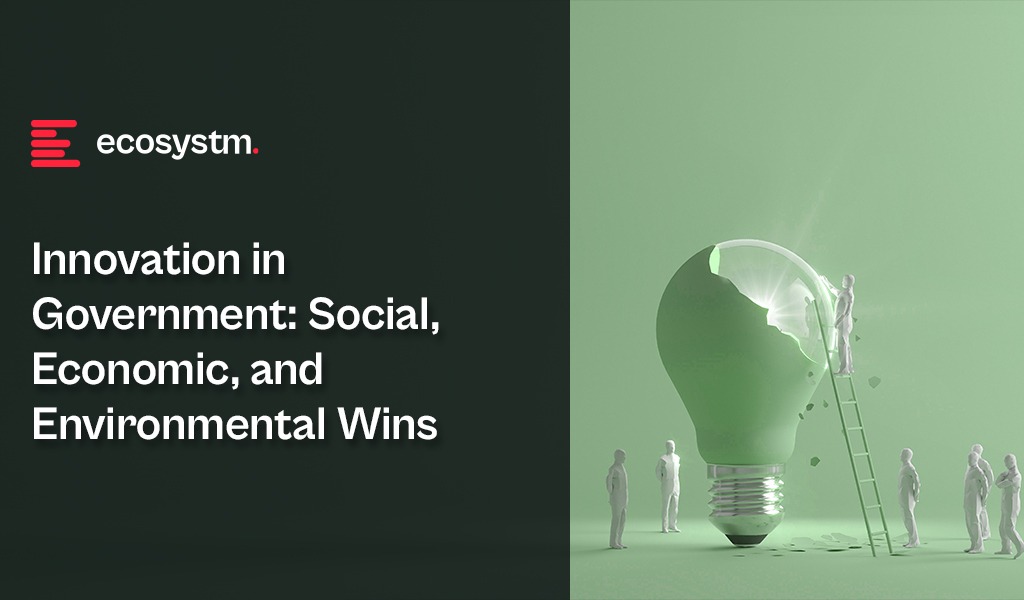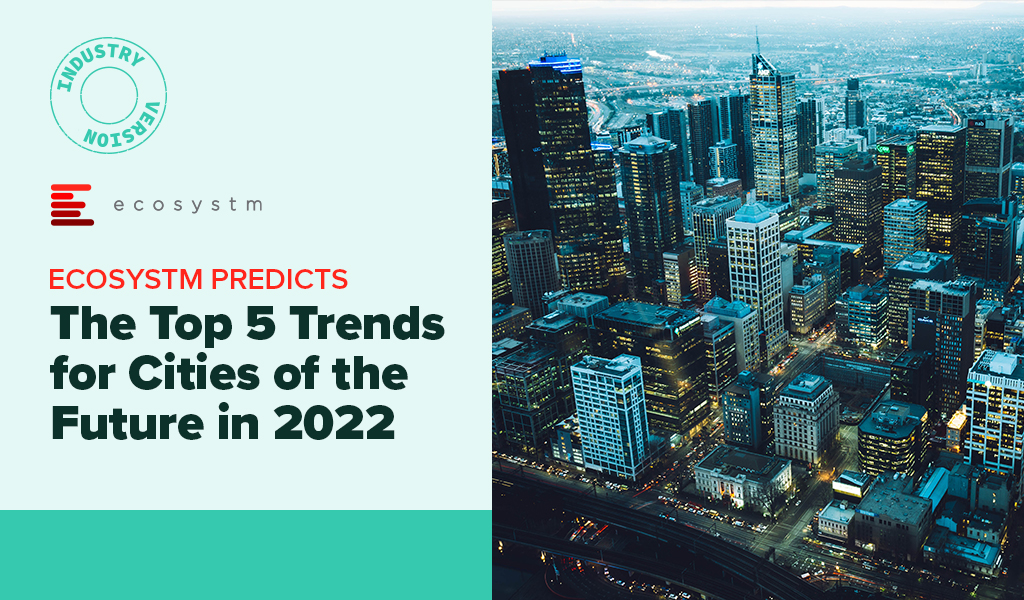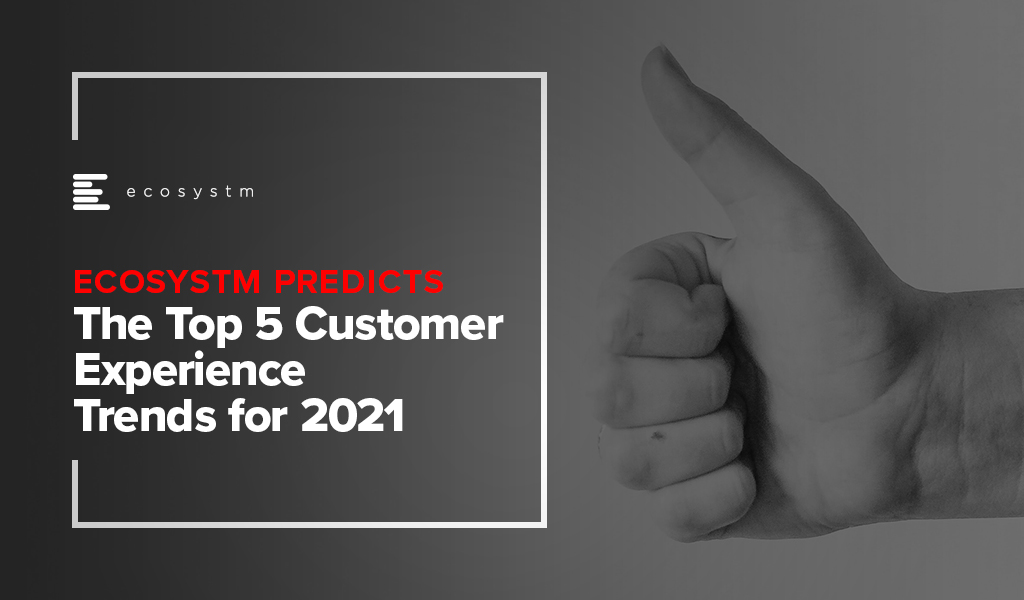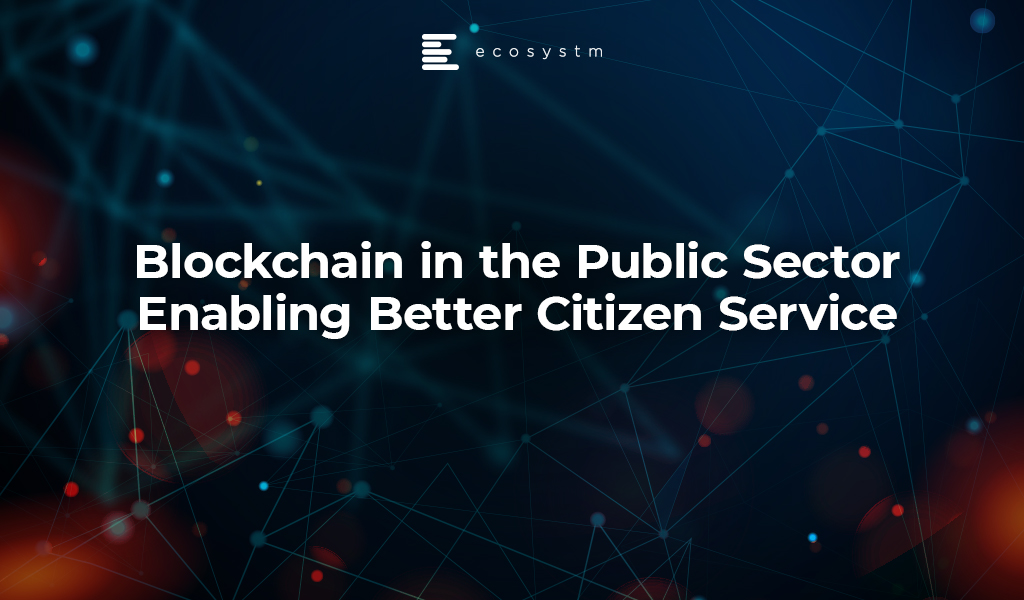We spoke about what public sector agencies should consider when building citizen-centric services. Integrating technology into organisational processes requires a similarly strategic approach that considers immediate needs, emerging enablers, and futuristic innovations.
Here is a comprehensive look at what public sector organisations should consider when integrating technology into processes.
1. Process Essentials: Laying the Groundwork
The immediate view focuses on deploying technologies that are widely adopted and essential for current digital service provision. These foundational technologies serve as the backbone for enhancing process efficiency.
- Code. At the most basic level, the foundation is built on code – the programming languages and frameworks used to create digital services. This includes technologies like HTML, CSS, JavaScript, Java, Python, etc. A typical approach is to have a front-end web layer for the user interface and a back-end application layer for processing.
- Monolithic ERP. These systems are also crucial, especially in the early stages. These integrated software suites help manage core functions like customer management and document handling. They provide comprehensive, pre-built solutions that can be customised to specific needs. ERPs enable organisations to effectively manage complex processes from the start.
2. Emerging Catalysts: Accelerating Processes
As organisations establish foundational technologies, they should look towards second-generation enablers. Although less mature, these technologies offer emerging digital opportunities, and can significantly enhance service differentiation, through improved processes.
- PaaS. As digital services mature, organisations can leverage platform-as-a-service (PaaS) solutions hosted in the cloud. PaaS provides greater scalability, flexibility, and reduced infrastructure management overhead compared to custom development approaches. Adopting a microservices architecture on PaaS allows for developing independent components that can be updated independently, promoting continuous improvement. This modern, modular approach is highly efficient.
- Low Code/ No Code. LC/NC platforms further simplify application development by providing intuitive, visual tools that don’t require extensive coding expertise. They build on PaaS capabilities while minimising the need for deep technical skills. These environments also facilitate collaboration by enabling partners and third-parties to easily create custom solutions that integrate with the organisation’s systems. This spurs innovation through an ecosystem of complementary apps and services.
3. Future-Forward Capabilities: Next-Gen Processes
The futuristic view focuses on forward-looking technologies that address long-term roadblocks and offer transformative potential. These technologies are currently speculative but hold the promise of significantly reshaping the market.
- Complex RPA and ML. Robotic process automation (RPA) and machine learning take technological maturity to the next level by automating routine tasks and optimising decision-making through intelligent algorithms. The integration of RPA with machine learning goes beyond simple automation to enable more complex, data-driven decision processes across the workflow. Analysts predict that by 2025, up to 50% of work could be automated this way, drastically improving efficiency.
- Enterprise-Wide Microservices Architecture. An enterprise-wide microservices architecture represents an advanced approach suitable for collaboration between agencies, technical service providers, and partners. Each microservice is designed to be independently deployable, testable, and focused on specific capabilities. This decentralised model allows services to be updated or replaced without disrupting the entire system, enhancing resilience. On a PaaS platform, it enables an agile, scalable approach aligned with modern e-government needs.
- Industry Cloud. The Industry Cloud is essentially a highly configurable PaaS solution, designed to meet the specific needs of not just one government agency or jurisdiction, but with adaptability for broader use.
Ecosystm Opinion
A comprehensive roadmap should outline how to build upon current process foundations with emerging catalysts like cloud platforms and low-code development, while actively preparing for future-forward capabilities around automation, microservices architectures, and industry cloud solutions.
By taking a long-term, systematic approach to integrating technology at every stage of the process lifecycle, agencies can cultivate an adaptable digital process ecosystem that continually evolves in lockstep with technological innovation. The goal is to foster processes that don’t just endure disruption, but fundamentally improve because of it – cementing organisational resilience and agility for decades to come.

Innovation is a driving force behind new approaches, often occurring at the point of adoption rather than technology development. As public sector organisations increasingly focus on improving citizen services through technology, it is important to adopt a strategic approach that considers innovation as a complex journey of systemic and cultural transformation. This strategic approach should guide the integration of technology into citizen services.
Here is a comprehensive look at what public sector organisations should consider when integrating technology into citizen services.
Download ‘Future-Proofing Citizen Services: Technology Strategies for the Public Sector‘ as a PDF
1. Immediate View: Foundational Technologies
The immediate view focuses on deploying technologies that are widely adopted and essential for current digital service provision. These foundational technologies serve as the backbone for enhancing citizen services.
Foundational Technologies
Web 2.0. Establishing a solid online presence is usually the first step, as it is the broadest channel for reaching customers. Web 2.0 refers to the current state of the internet, encompassing dynamic content and interactive websites.
Mobile Applications. Given that mobile usage has surpassed desktop, a mobile-responsive platform or a dedicated mobile app is crucial. Mobile apps provide a more specialised and immersive user experience by utilising device-specific features like GPS, document scanning, and push notifications.
2. Second-Generation Enablers: Emerging Technologies
As organisations establish foundational technologies, they should look towards second-generation enablers. Although less mature, these technologies offer emerging digital opportunities, and can significantly enhance service differentiation.
Emerging Technologies
Interactive Voice Response (IVR) systems improve the efficiency and effectiveness of digital services by routing callers to self-service options and providing relevant information without human intervention. These systems operate outside typical government agency working hours, ensuring continuous accessibility. Additionally, IVRs generate valuable data for future Voice of the Customer programs, improving overall service quality and responsiveness.
Digital Wallets facilitate transactions by expediting fund transfers and enhancing transparency through meticulous transaction records. They streamline administrative tasks, simplify transactions, and encourage service usage and adoption.
AI-driven Virtual Agents or chatbots revolutionise customer interactions by providing 24/7 support. They offer prompt, efficient, and personalised services, enhancing customer satisfaction and trust. In resource-limited public sectors, virtual agents are cost-effective, optimising resource allocation and meeting growing service demands. Specialised virtual agents for specific sectors can further differentiate service providers.
3. Futuristic View: Ambitious Innovations
The futuristic view focuses on forward-looking technologies that address long-term roadblocks and offer transformative potential. These technologies are currently speculative but hold the promise of significantly reshaping the market.
Innovations
Subscription Management models enable public sector information services to be accessed in highly personalised ways, thereby enhancing citizen engagement. This model supports regulatory oversight by providing common data insights and improves the management of services, ultimately benefiting the public by ensuring more responsive and tailored information delivery.
AI concierge leverages advanced technologies like Natural Language Processing, Computer Vision, and Speech Technologies to provide personalised and proactive customer service. They redefine customer management, ensuring a seamless and tailored experience.
Immersive reality technologies, such as augmented and virtual reality (AR/VR) create captivating customer experiences by allowing interactions in virtual environments. These technologies establish a shared virtual environment, helping customers to engage with businesses and each other in new and immersive ways. As an emerging customer management tool, immersive reality can transform the dynamics of customer-business relationships, adding substantial value to the service experience.

Governments worldwide struggle with intricate social, economic, and environmental challenges. Tight budgets often leave them with limited resources to address these issues head-on. However, innovation offers a powerful path forward.
By embracing new technologies, adapting to cultural shifts, and fostering new skills, structures, and communication methods, governments can find solutions within existing constraints.
Find out how public sector innovation is optimising internal operations, improving service accessibility, bridging the financial gap, transforming healthcare, and building a sustainable future.
Click here to download ‘Innovation in Government: Social, Economic, and Environmental Wins’ as a PDF
Optimising Operations: Tech-Driven Efficiency
Technology is transforming how governments operate, boosting efficiency and allowing employees to focus on core functions.
Here are some real-world examples.
Singapore Streamlines Public Buses. A cloud-based fleet management system by the Land Transport Authority (LTA) improves efficiency, real-time tracking, data analysis, and the transition to electric buses.
Dubai Optimises Utilities Through AI. The Dubai Electricity and Water Authority (DEWA) leverages AI for predictive maintenance, demand forecasting, and grid management. This enhances service reliability, operational efficiency, and resource allocation for power and water utilities.
Automation Boosts Hospital Efficiency. Singapore hospitals are using automation to save man-hours and boost efficiency. Tan Tock Seng Hospital automates bacteria sample processing, increasing productivity without extra staff, while Singapore General Hospital tracks surgical instruments digitally, saving thousands of man-hours.
Tech for Citizens
Digital tools and emerging technologies hold immense potential to improve service accessibility and delivery for citizens. Here’s how governments are leveraging tech to benefit their communities.
Faster Cross-Border Travel. Malaysia’s pilot QR code clearance system expedites travel for factory workers commuting to Singapore, reducing congestion at checkpoints.
Metaverse City Planning. South Korea’s “Metaverse 120 Center” allows residents to interact with virtual officials and access services in a digital environment, fostering innovative urban planning and infrastructure management.
Streamlined Benefits. UK’s HM Revenue and Customs (HMRC) launched an online child benefit claim system that reduces processing time from weeks to days, showcasing the efficiency gains possible through digital government services.
Bridging the Financial Gap
Nearly 1.7 billion adults or one-third globally, remain unbanked.
However, innovative programs are bridging this gap and promoting financial inclusion.
Thailand’s Digital Wallet. Aimed at stimulating the economy and empowering underserved citizens, Thailand disburses USD 275 via digital wallets to 50 million low-income adults, fostering financial participation.
Ghana’s Digital Success Story. The first African nation to achieve 100% financial inclusion through modernised platforms like Ghana.gov and GhanaPay, which facilitate payments and fee collection through various digital channels.
Philippines Embraces QR Payments. The City of Alaminos leverages the Paleng-QR Ph Plus program to promote QR code-based payments, aligning with the central bank’s goal of onboarding 70% of Filipinos into the formal financial system by 2024.
Building a Sustainable Future
Governments around the world are increasingly turning to technology to address environmental challenges and preserve natural capital.
Here are some inspiring examples.
World’s Largest Carbon Capture Plant. Singapore and UCLA joined forces to build Equatic-1, a groundbreaking facility that removes CO2 from the ocean and creates carbon-negative hydrogen.
Tech-Enhanced Disaster Preparedness. The UK’s Lincolnshire County Council uses cutting-edge geospatial technology like drones and digital twins. This empowers the Lincolnshire Resilience Forum with real-time data and insights to effectively manage risks like floods and power outages across their vast region.
Smart Cities for Sustainability. Bologna, Italy leverages the digital twins of its city to optimise urban mobility and combat climate change. By analysing sensor data and incorporating social factors, the city is strategically developing infrastructure for cyclists and trams.
Tech for a Healthier Tomorrow
Technology is transforming healthcare delivery, promoting improved health and fitness monitoring.
Here’s a glimpse into how innovation is impacting patient care worldwide.
Robotic Companions for Seniors. South Korea tackles elder care challenges with robots. Companion robots and safety devices provide companionship and support for seniors living alone.
VR Therapy for Mental Wellness. The UAE’s Emirates Health Services Corporation implements a Virtual Reality Lab for Mental Health, that creates interactive therapy sessions for individuals with various psychological challenges. VR allows for personalised treatment plans based on data collected during sessions.

Technology is reshaping the Public Sector worldwide, optimising operations, improving citizen services, and fostering data-driven decision-making. Government agencies are also embracing innovation for effective governance in this digital era.
Public sector organisations worldwide recognise the need for swift and agile interventions. With citizen expectations resembling those of commercial customers, public sector organisations face mounting pressure to break down the barriers to provide seamless service experiences.
Read on to find out how public sector organisations in countries such as Australia, Vietnam, the Philippines, South Korea, and Singapore are innovating to stay ahead of the curve; and what Ecosystm VP Consulting, Peter Carr sees as the Future of Public Sector.
Click here to Download ‘The Future of the Public Sector’ as a PDF

Organisations are moving beyond digitalisation to a focus on building market differentiation. It is widely acknowledged that customer-centric strategies lead to better business outcomes, including increased customer satisfaction, loyalty, competitiveness, growth, and profitability.
AI is the key enabler driving personalisation at scale. It has also become key to improving employee productivity, empowering them to focus on high-value tasks and deepening customer engagements.
Over the last month – at the Salesforce World Tour and over multiple analyst briefings – Salesforce has showcased their desire to solve customer challenges using AI innovations. They have announced a range of new AI innovations across Data Cloud, their integrated CRM platform.
Ecosystm Advisors Kaushik Ghatak, Niloy Mukherjee, Peter Carr, and Sash Mukherjee comment on Salesforce’s recent announcements and messaging.
Read on to find out more.
Download Ecosystm VendorSphere: Salesforce AI Innovations Transforming CRM as a PDF

Cities worldwide have been facing unexpected challenges since 2020 – and 2022 will see them continue to struggle with the after-effects of COVID-19. However, there is one thing that governments have learnt during this ongoing crisis – technology is not the only aspect of a Cities of the Future initiative. Besides technology, Cities of the Future will start revisiting organisational and institutional structures, prioritise goals, and design and deploy an architecture with data as its foundation.
Cities of the Future will focus on being:
- Safe. Driven by the ongoing healthcare crisis
- Secure. Driven by the multiple cyber attacks on critical infrastructure
- Sustainable. Driven by citizen consciousness and global efforts such as the COP26
- Smart. Driven by the need to be agile to face future uncertainties
Read on to find out what Ecosystm Advisors, Peter Carr, Randeep Sudan, Sash Mukherjee and Tim Sheedy think will be the leading Cities of the Future trends for 2022.
Click here to download Ecosystm Predicts: The Top 5 Trends for Cities of the Future in 2022

In 2020, much of the focus for organisations were on business continuity, and on empowering their employees to work remotely. Their primary focus in managing customer experience was on re-inventing their product and service delivery to their customers as regular modes were disrupted. As they emerge from the crisis, organisations will realise that it is not only their customer experience delivery models that have changed – but customer expectations have also evolved in the last few months. They are more open to digital interactions and in many cases the concept of brand loyalty has been diluted. This will change everything for organisations’ customer strategies. And digital technology will play a significant role as they continue to pivot to succeed in 2021 – across regions, industries and organisations.
Ecosystm Advisors Audrey William, Niloy Mukherjee and Tim Sheedy present the top 5 Ecosystm predictions for Customer Experience in 2021. This is a summary of the predictions – the full report (including the implications) is available to download for free on the Ecosystm platform.
The Top 5 Customer Experience Trends for 2021
- Customer Experience Will Go Truly Digital
COVID-19 made the few businesses that did not have an online presence acutely aware that they need one – yesterday! We have seen at least 4 years of digital growth squeezed into six months of 2020. And this is only the beginning. While in 2020, the focus was primarily on eCommerce and digital payments, there will now be a huge demand for new platforms to be able to interact digitally with the customer, not just to be able to sell something online.
Digital customer interactions with brands and products – through social media, online influencers, interactive AI-driven apps, online marketplaces and the like will accelerate dramatically in 2021. The organisations that will be successful will be the ones that are able to interact with their customers and connect with them at multiple touchpoints across the customer journey. Companies unable to do that will struggle.
- Digital Engagement Will Expand Beyond the Traditional Customer-focused Industries
One of the biggest changes in 2020 has been the increase in digital engagement by industries that have not traditionally had a strong eye on CX. This trend is likely to accelerate and be further enhanced in 2021.
Healthcare has traditionally been focused on improving clinical outcomes – and patient experience has been a byproduct of that focus. Many remote care initiatives have the core objective of keeping patients out of the already over-crowded healthcare provider organisations. These initiatives will now have a strong CX element to them. The need to disseminate information to citizens has also heightened expectations on how people want their healthcare organisations and Public Health to interact with them. The public sector will dramatically increase digital interactions with citizens, having been forced to look at digital solutions during the pandemic.
Other industries that have not had a traditional focus on CX will not be far behind. The Primary & Resources industries are showing an interest in Digital CX almost for the first time. Most of these businesses are looking to transform how they manage their supply chains from mine/farm to the end customer. Energy and Utilities and Manufacturing industries will also begin to benefit from a customer focus – primarily looking at technology – including 3D printing – to customise their products and services for better CX and a larger share of the market.
- Brands that Establish a Trusted Relationship Can Start Having Fun Again
Building trust was at the core of most businesses’ CX strategies in 2020 as they attempted to provide certainty in a world generally devoid of it. But in the struggle to build a trusted experience and brand, most businesses lost the “fun”. In fact, for many businesses, fun was off the agenda entirely. Soft drink brands, travel providers, clothing retailers and many other brands typically known for their fun or cheeky experiences moved the needle to “trust” and dialed it up to 11. But with a number of vaccines on the horizon, many CX professionals will look to return to pre-pandemic experiences, that look to delight and sometimes even surprise customers.
However, many companies will get this wrong. Customers will not be looking for just fun or just great experiences. Trust still needs to be at the core of the experience. Customers will not return to pre-pandemic thinking – not immediately anyway. You can create a fun experience only if you have earned their trust first. And trust is earned by not only providing easy and effective experiences, but by being authentic.
- Customer Data Platforms Will See Increased Adoption
Enterprises continue to struggle to have a single view of the customer. There is an immense interest in making better sense of data across every touchpoint – from mobile apps, websites, social media, in-store interactions and the calls to the contact centre – to be able to create deeper customer profiles. CRM systems have been the traditional repositories of customer data, helping build a sales pipeline, and providing Marketing teams with the information they need for lead generation and marketing campaigns. However, CRM systems have an incomplete view of the customer journey. They often collect and store the same data from limited touchpoints – getting richer insights and targeted action recommendations from the same datasets is not possible in today’s world. And organisations struggled to pivot their customer strategies during COVID-19. Data residing in silos was an obstacle to driving better customer experience.
We are living in an age where customer journeys and preferences are becoming complex to decipher. An API-based CDP can ingest data from any channel of interaction across multiple journeys and create unique and detailed customer profiles. A complete overhaul of how data can be segregated based on a more accurate and targeted profile of the customer from multiple sources will be the way forward in order to drive a more proactive CX engagement.
- Voice of the Customer Programs Will be Transformed
Designing surveys and Voice of Customer programs can be time-consuming and many organisations that have a routine of running these surveys use a fixed pattern for the data they collect and analyse. However, some organisations understand that just analysing results from a survey or CSAT score does not say much about what customers’ next plan of action will be. While it may give an idea of whether particular interactions were satisfactory, it gives no indication of whether they are likely to move to another brand; if they needed more assistance; if there was an opportunity to upsell or cross sell; or even what new products and services need to be introduced. Some customers will just tick the box as a way of closing off a feedback form or survey. Leading organisations realise that this may not be a good enough indication of a brand’s health.
Organisations will look beyond CSAT to other parameters and attributes. It is the time to pay greater attention to the Voice of the Customer – and old methods alone will not suffice. They want a 360-degree view of their customers’ opinions.

Governments across the globe are realising the true potential of emerging technologies to provide better citizen services and to ensure transparency and accountability. Blockchain is one of the emerging technologies that is helping and will continue to help governments to achieve transformation. Government departments and agencies are being increasingly pushed to be collaborative and share data across agencies, while at the same time maintain the security of the data in their care. A distributed ledger that can share information based on agreed-upon protocols helps governments immensely in collaborating without losing accountability.
What are the key priorities of public sector organisations? The global Ecosystm CX study finds that citizens and employees are the top priorities for government agencies and departments.
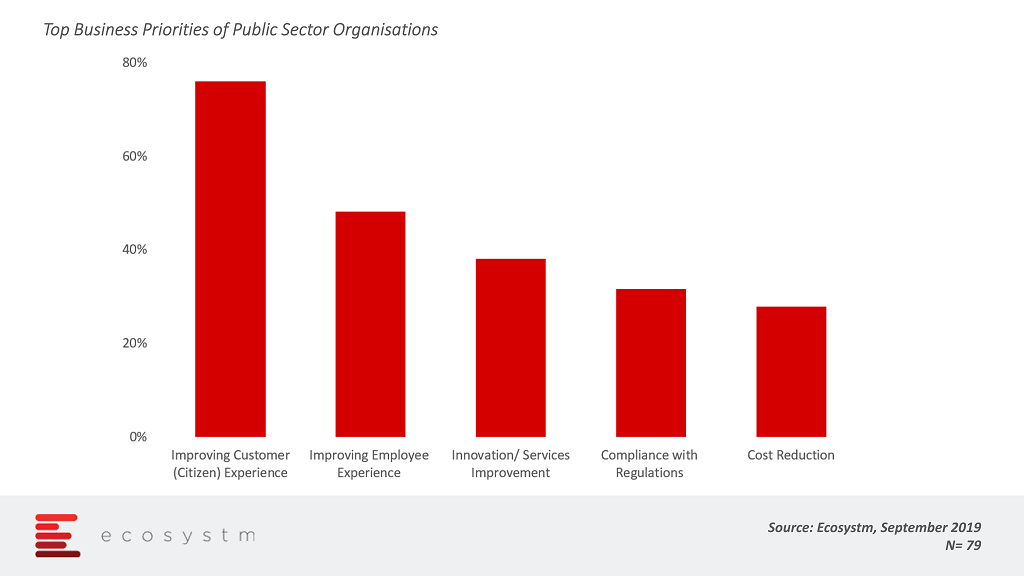
Blockchain can help the public sector achieve many of its goals –
Improving Citizen Services
As more countries aim to be eGovernments, there is a need for real-time data access, information management, and fraud prevention. Blockchain is enabling governments to provide innovative services to citizens. It is possible now to decentralise the citizen database, reducing the time and cost of fetching records. Moreover, Blockchain enhances transparency and makes the highly regulated public sector audit-ready by creating a single source of truth for all connected devices and stakeholders.
One of the earliest use cases we see is in records management. Population records are useful for several agencies from healthcare to civil services to welfare departments. In Myanmar, UNICEF has collaborated with the industry to introduce a mobile birth and death registration system based on Blockchain. This digital mobile recording system is maintained on an integrated platform controlled by several parties who maintain birth and death records of Myanmar’s citizens and is a step towards achieving universal registration.
Citizen services such as notarisation, recording and time-stamping events, transactional real-estate contracts, online storing and verification of academic degrees, identity management and so on are benefiting from Blockchain deployment.
In Georgia, the government department of Land, Property and Housing Management is using Blockchain to maintain land and property records. The blockchain-based land registry allows speedier approvals with no involvement of paperwork or multi-party signatures on physical documents. This is enhancing service quality while offering better security measures as the data is digitally stored in the National Agency of Public Registry’s land title database.
Improving Employee Experience
Maintaining massive records about individuals, organisations, assets, activities, location and national information by the government department employees is a time-consuming process. In addition to this, managing and updating the ever-growing records is made more difficult by data silos and information management protocols and of course errors creep in.
Blockchain is streamlining the workflow and information management system at an individual as well as at a departmental level. In government departments, Blockchain can redefine processes by including events and agents in a block-based system where each activity can be easily managed and accounted for. This prevents issues such as miscounts, delayed processes and slipped deadlines.
The Chilean National Energy Commission has piloted a Blockchain platform to regulate the energy sector such as installed capacity, average market price, marginal costs, hydrocarbons and more. To implement this, first the energy data was stored on an Open Energy database which was then distributed across hundreds of secure servers countrywide. Later the employees verified anomalies which minimised their workload and made it convenient to edit the central database. The information added to open ledger is readily available to employees and citizens.
Compliance with Regulations
One of the primary benefits of Blockchain technology in the public sector is compliance. The transactions recorded on distributed ledgers are documented in a central ledger providing a comprehensive, precise, irreversible, permanent and secure trail. For instance, Blockchain is used to streamline cross-border compliance adherence by matching the data with the actual trade transactions. This creates an efficient and secure system ensuring real-time compliance, significant reduction of transaction costs, elimination of customs evasion and fraud from the outset.
In June, the Chinese Customs deployed its cross-border Blockchain compliance solution. The platform aims to increase efficiency by monitoring the flow of imports and exports and helping with risk assessments and document management. As transaction information can be stored safely and transparently on a Blockchain, the platform enables easy identification of documents to be checked, making compliance easier.
Data Management and Privacy
Blockchain acts as a default record keeper for society and governments and prevents the data from being misused by criminals and hackers. Through the responsible deployment of Blockchain data structures, governments can strengthen network security by reducing risks of single points-of-failure and preventing data breaches.
Democracy Earth – a Blockchain-based community has established a decentralised online governance platform, entirely built on open source technologies. The website helps users to cast votes on various policies based on tokens assigned to the users. This also minimises expenses and creates a secure information flow in a Blockchain-based voting system.
Government agencies, such as the U.S. Department of Homeland Security (DHS), are also getting serious about Blockchain applications in data management and privacy. DHS is funding R&D in Blockchain start-ups to explore new approaches to cybersecurity. The U.S. military is also utilising Blockchain (SIMBA Chain) to secure its military communication, messaging and applications. Blockchain is used for communication between ground troops and their headquarters. In addition to securing communications, the US Airforce is using Blockchain to track 3D printed components throughout their life cycle. With SIMBA, the top-secret printing blueprints are shared without much surveillance – this has enabled the Department of Defense to maintain a digital library of parts.
Cost Reductions
The government has clear citizen responsibilities and fulfilling them with a limited set of resources is one of the prime challenges for public departments. Reconciling expenditure with the budget is a time-consuming, and expensive procedure. Blockchain-based payment and accounting systems can help governments to reduce process costs by removing redundancies, streamlining processes, decreasing audit burden and ensuring systems integrity. By removing the requirement for third-party agencies to handle operations and maintain records, Blockchain technology is helping governments to reduce costs.
Blockchain is still an emerging concept with significant benefits. The Ecosystm IoT study finds that only 20% of public sector IT decision-makers are fully aware of the capabilities and limitations of Blockchain. Adopters and developers are still resolving the challenges. On the technology side, there are concerns on platform scalability, integration, standardisation and validation methods. On the management side, there are concerns about business models, transaction scale, maturity, and structure. However, government agencies will benefit immensely from the technology in the near future.























